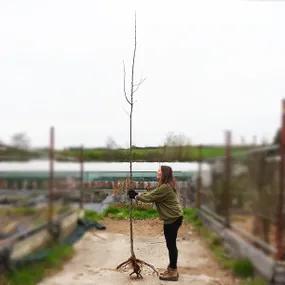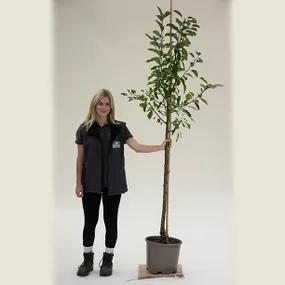John Downie Crab Apple, Large Trees
Honest Delivery Prices- Native. Large orange-yellow fruit are best for jam, jelly etc.
- One of the two best orchard pollinators.
- Max. Height: 7-8m
- Bareroot Delivery: Nov-Mar.
Recommended extras
Description
Malus John Downie: Bareroot John Downie Crab Apple Trees in Standard Sizes
John Downie crab apple trees are attractive and make heavy crops of some of the best crab apples for use in the kitchen. They are commonly planted in orchards and their narrow canopy makes them a great specimen tree for a small garden. It has abundant white blossom in mid-late spring and good red-gold autumn colour. The long, conical, bright red-orange fruit are some of the prettiest of any crab apple. They don't remain for long on the branches when ripe, which is fine because they make great crab apple jelly or apple sauce, and can be blended into a cider brew.
Vigorous yet naturally tidy, it can reach a height of about 6-8 metres. Half standards will reach approximately 4 metres.
Browse our variety of crab apple trees, or our range of ornamental garden trees.
Delivery season: Crab apple trees are delivered bareroot during late autumn and winter, approximately November-March inclusive.
Choosing a size: Small trees are cheaper, easier to handle and more forgiving of less than ideal aftercare, so they are best for a big planting project. If instant impact is your priority, or if you are only buying a few plants for use in a place where it is convenient to water them well in their first year, then you may as well use bigger ones. All our bareroot trees are measured by their height in centimetres above the ground (the roots aren't measured).
Features:
- Height: 6-8m
- Soil: Any well drained
- Use: Specimen, edible fruit, small garden, urban
- Colour: White blossom in late April-May. Bright red-orange fruit
- Excellent fruit for cooking
- Great orchard pollinator
- Bareroot delivery only: November-March
Growing John Downie Crab Apples
Any well drained soil. Suitable for large containers designed for trees. Full sun or partial shade. Tolerant of pollution.
Moderately susceptible to scab.
It is one of the best pollinators for apple orchards, along with Golden Hornet.
Tip for harvesting: The ripe fruit drop easily from the tree, so as soon as you see one fall, put a tarp on the ground and shake the tree.
Planting Instructions
Notes on planting Malus John Downie:
Crabapples are tough plants that thrive in any moderately fertile soil. They tolerate shade well, although we recommend planting them in full sun to get the best display of flowers and fruit. Although a moist, well drained site is ideal, crabapples like heavy clay and don't mind a bit of waterlogging in winter.
They won't grow in deep shade and may struggle in very poor dry soil.
Prepare your site before planting:
It is good to dig over the site where you plant a tree several months in advance. Kill the weeds first: for tough weeds like nettles, brambles and ground elder, you will usually need a weed-killer to get rid of them. When you dig the soil over, remove stones and other rubbish and mix in well rotted compost or manure down to the depth of about 2 spades.
Watch our video on how to plant a tree for full instructions.
Remember to water establishing trees during dry weather for at least a year after planting.
Tree Planting accessories:
Prepare your site for planting by killing the weeds and grass.
You can buy a tree planting pack with a wooden stake & rubber tie to support the tree and a mulch mat with pegs to protect the soil around the base of your tree from weeds and drying out.
We suggest that you use mycorrhizal "friendly fungi" on the roots of all newly planted large trees: if your soil quality is poor, we strongly recommend it.
You can also improve your soil with bonemeal organic fertiliser.
Did You Know?
This tree was bred in the 1875 by Edward Holmes in Lichfield and named after his friend, a Scottish nurseryman who worked at Handsworth Nurseries in Sheffield.
Standard trees are measured by their girth in centimetres 1 metre above ground level: their trunk's waist measurement. Unlike sapling trees and hedge plants, standards aren't measured by their height, which will vary quite a bit both between and within species.
So, a 6/8cm standard tree has a trunk with a circumference of 6-8cm and an 8/10 standard has a trunk 8-10cm around. This measurement makes no difference to the tree's final height.
On average, standard trees are 2-3.5 metres tall when they arrive, but we cannot tell you precisely how tall your trees will be before we deliver them.

 1.webp)
 1.webp)

 2.webp)
 3.webp)

